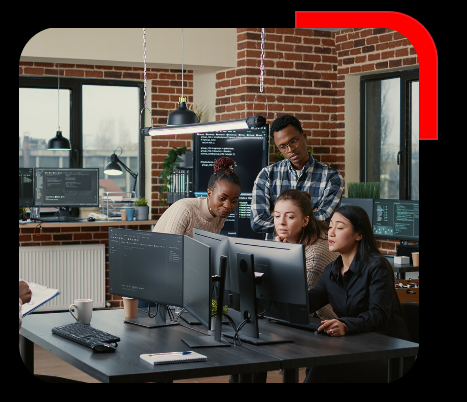Customer Experiences:
Creating a Virtuous Cycle

The Opportunities
The Customer Experience is the other side of our landing page’s vicious/virtuous cycle. Sadly, many workers are actively disengaged in their jobs1, with high terminations and on-the-job quitting rates. The case for active engagement, employee satisfaction, retention, and employee recognition programs demonstrates how they impact the organization’s bottom line or, for nonprofits, support accomplishing their missions.
According to a recent report from Gallup and People-Management software company Workhuman2, 81% of leaders surveyed said employee recognition isn’t a company priority, and roughly two-thirds said they have no budget. Just 23% of employees strongly agreed that they were satisfied with the amount of recognition they received. So, are you training your competitor’s next new hire?


Research demonstrates a direct correlation between managers’ engagement with employees, delivering regular and effective feedback, and recognition and the impact on employees’ performance. Further, managers tend to overestimate how they communicate and express that gratitude. Structured programs such as financial performance incentives are more likely to drive satisfaction and belonging, according to the research. But less formal initiatives also carry more weight than leaders often realize.
Do you remember hearing years ago that for every bad customer experience, the customer will tell ten people, they will tell ten others, and so it goes? Research about that number today varies, but our experience suggests a number greater than 15 at each stage. What that equates to in dollars and cents is anybody’s guess, but it is likely high. And that might not necessarily include the cost of poorly received e-mail, social media, and text message campaigns tainted by ever-increasing negative word of mouth.
Now in our new normal, we continue to face a different challenge that has changed our business models since around 2020, specifically how the pandemic impacted our ability to serve our customers effectively. Companies must continue reinventing workplace processes and services to ease client engagement. They generally don’t care where your employees work – at home, off-site, or hybrid. They still want quality service and great products delivered on time with high quality. Calls and correspondence need to be answered quickly and professionally. They expect us to be prepared for issues that demand effective and immediate problem-solving to meet their needs and provide helpful service recovery in situations that did not go well initially. Further, we sometimes forget that the customer may be dealing with similar issues at their workplace, which increases frustration or dissatisfaction when they see it with their vendors.


An essential factor in the CX equation is employee training and ensuring seamless interactions with these new remote workers. This includes embracing emerging technologies for your company to be seen as innovative. Technology has prepared us better for effective remote communications. When used well, products like Zoom, Microsoft Teams, Skype, and RingCentral have become increasingly part of daily organizational communication within and across our teams. But typically, that is an aid for the company rather than the customer. But no matter how clear your message is and how you utilize technology, certain obstacles will still be encountered in communicating effectively with customers that training and excellent customer support will rectify.

Planning, IT funding, and a lack of new 21st-century thinking can contribute to a lackluster CX rating. A smart CX strategy, supporting technology, and an appropriate budget should replace systems of yesterday and outdated work processes that still prioritize short-term profits over establishing and maintaining long-term relationships. Not all companies can be successful based on some of these factors, tied in with the size of their organization and lack of a mission or growth through superior CX.
AI is here to stay, but not all businesses are equipped for that expense, and senior leadership may not be sold on that as a line item on the budget.
All this is influenced by an increased focus on Diversity, Equity, Inclusion, and Belonging in recent years. As noted under our Employee Experience section, a compelling case exists for DEIB within companies to improve the employee experience. The same point can be made for the customer experience: Our customers come from all backgrounds and identities, all of whom want to be treated with respect and dignity, which can vary based on their points of view. A sound Customer Experience approach must understand these differences and incorporate this appreciation into skill-based interactions. In addition, your CX teams should include members who align with the diversity of your customers, contributing to more satisfying and productive interactions.


Capture teaches our customers to design and implement a Proactive Service Recovery plan to anticipate and address service slips and to turn around bad experiences. The goal is to make the experience seamless. Customers often judge service providers from their initial experiences and, more importantly, how they respond to service recovery. A proactive service recovery strategy is anticipated so the service provider can solve problems and implement recovery quickly. A reactive approach means that each incident is handled one by one without the benefit of prior guidance, which only elongates and continues to frustrate the customer. For example, a restaurant that serves hundreds of customers daily will have several opportunities to provide excellent recovery daily – but only if they plan for it.
A burnt meal, a wrong order, slow delivery, or a rude server can happen anytime and can and should be anticipated.
What determines if the customer returns is how the gap is addressed and what the customer will tell their friends. Customers expect that a process is already in place for apologies, manager interventions, comping meals, or providing a voucher for a future meal on the house. Loyal customers expect excellent service and will allow occasional missteps – if they experience effective recovery.


Through our experiences with clients, your customers are more likely to share positive experiences by showing their employees that they are valued as individuals where they can grow and thrive.
To stay competitive and maintain higher customer experience ratings, we must rethink our internal Employee Experience strategies, such as recruitment, engagement, and retention, which are informed by your Customer Experience. Let CapturePPG assist you in creating a virtuous cycle!
All of our research is done using a CATI system (computer-aided-telephonic interviewing) to capture results of all research. The CATI system allows the IT programmers to create a questionnaire complete with all skip patterns, sample and quota management, and questionnaire tasks that move the interview through questionnaire twists and turns as needed. The flexibility of this system also allows us to customize each telephone or web survey based on the needs of the client, as well as to provide the information needed for the researcher to enable probing and overall research requirements.
Capture’s research includes general survey research of businesses and consumers. We work with our client-partners to create the best questionnaire possible to meet their objectives. Our customizable research and scripting tools work to provide you with the right information to make smart decisions for your business.
Consumer Research
- Increase profitability
- Gain client insights
- Encourage customer loyalty
- Demonstrate a commitment to client satisfaction
- Determine where quality can improve
- Provide a way for unhappy consumers to vent and learn about opportunities to Improve.
- Client satisfaction is tied directly to profitability
- Gain client insights on new products or services
- If your clients are happy, they tend to be more loyal and easier to retain
- Demonstrate a commitment to client satisfaction by listening to them
- Improve the quality of your service, and in turn, improve client satisfaction
Customer Loyalty
Customer loyalty is always critical to business success and profitability. Monitoring customer loyalty allows you to efficiently retain existing clientele and divert more resources toward acquiring new customers.
- Higher customer loyalty means higher profitability
- Identify customers likely to defect and the reasons why
- Improve customer retention
- Retaining current customers is 3 to 10 times cheaper than acquiring new ones
- Demonstrate to your customers that you not only care, but that you are seeking their input to improve your service and quality
- Assess satisfaction with front-line agents or methods of delivery
- Measure the effectiveness of the service provided
- Evaluate the way transactions are executed
- Determine user issues associated with the appearance and/or functionality of your service delivery methods
- Collect metrics to identify possible areas where improvement is warranted
Action Steps to Enhance Your Customer Experience
- Call monitoring is part of the job in a call center.
- Include customer “contact us” for them to share their experiences, good or bad.
- Sometimes, email or mail surveys should be offered to personalize the experience.
- Sampling outgoing calls and discussing them with a senior staff member (e.g., quality) is a great way to let the customer know you care.
- Communicate with past customers to check in and explore new products and services.
- To show appreciation, many employers conduct ongoing recognition programs to thank employees for their achievements in the CX space.
- Hand-written notes and envelopes continue to attract the customer’s attention.
- For call or customer care centers, always close the call with something that might be appreciated, such as:
- Apologize for complaints on behalf of your company, determine if you can solve their problems or arrive at closure, and offer follow-up as appropriate.
- Adding a custom statement such as “Have I answered all of your questions, Mr. Smith” or” Is there anything else I can do for you today?”
- Extend your closing where applicable, such as, “Ms. Johnson, you should receive a response in four or five days after we have researched our end. If you don’t,
- please let me know, and I’ll track it down,” in some cases, offering an express mail solution. Repeat your name and offer a direct line or extension if that is an option.
Please feel free to contact us by email through the form below.
Please allow 24 hours for reply. If you need faster service, please call us at the number on this page
CONTACT US
Contact
information:
Toll Free:
Main Office:
Port St. Lucie, FL 34953
